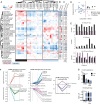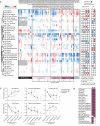Extensive and systematic rewiring of histone post-translational modifications in cancer model systems
- PMID: 29618087
- PMCID: PMC5934616
- DOI: 10.1093/nar/gky224
Extensive and systematic rewiring of histone post-translational modifications in cancer model systems
Abstract
Histone post-translational modifications (PTMs) generate a complex combinatorial code that regulates gene expression and nuclear functions, and whose deregulation has been documented in different types of cancers. Therefore, the availability of relevant culture models that can be manipulated and that retain the epigenetic features of the tissue of origin is absolutely crucial for studying the epigenetic mechanisms underlying cancer and testing epigenetic drugs. In this study, we took advantage of quantitative mass spectrometry to comprehensively profile histone PTMs in patient tumor tissues, primary cultures and cell lines from three representative tumor models, breast cancer, glioblastoma and ovarian cancer, revealing an extensive and systematic rewiring of histone marks in cell culture conditions, which includes a decrease of H3K27me2/me3, H3K79me1/me2 and H3K9ac/K14ac, and an increase of H3K36me1/me2. While some changes occur in short-term primary cultures, most of them are instead time-dependent and appear only in long-term cultures. Remarkably, such changes mostly revert in cell line- and primary cell-derived in vivo xenograft models. Taken together, these results support the use of xenografts as the most representative models of in vivo epigenetic processes, suggesting caution when using cultured cells, in particular cell lines and long-term primary cultures, for epigenetic investigations.
Figures





Similar articles
-
SILAC-based proteomic analysis to dissect the "histone modification signature" of human breast cancer cells.Amino Acids. 2011 Jul;41(2):387-99. doi: 10.1007/s00726-010-0668-2. Epub 2010 Jul 9. Amino Acids. 2011. PMID: 20617350
-
PAT-H-MS coupled with laser microdissection to study histone post-translational modifications in selected cell populations from pathology samples.Clin Epigenetics. 2017 Jul 11;9:69. doi: 10.1186/s13148-017-0369-8. eCollection 2017. Clin Epigenetics. 2017. PMID: 28702092 Free PMC article.
-
Global histone modification profiling reveals the epigenomic dynamics during malignant transformation in a four-stage breast cancer model.Clin Epigenetics. 2016 Mar 31;8:34. doi: 10.1186/s13148-016-0201-x. eCollection 2016. Clin Epigenetics. 2016. PMID: 27034728 Free PMC article.
-
Mass spectrometry-based characterization of histones in clinical samples: applications, progress, and challenges.FEBS J. 2022 Mar;289(5):1191-1213. doi: 10.1111/febs.15707. Epub 2021 Jan 23. FEBS J. 2022. PMID: 33415821 Free PMC article. Review.
-
Integrative Chemical Biology Approaches to Deciphering the Histone Code: A Problem-Driven Journey.Acc Chem Res. 2021 Oct 5;54(19):3734-3747. doi: 10.1021/acs.accounts.1c00463. Epub 2021 Sep 23. Acc Chem Res. 2021. PMID: 34553920 Review.
Cited by
-
KMT5A-methylated SNIP1 promotes triple-negative breast cancer metastasis by activating YAP signaling.Nat Commun. 2022 Apr 21;13(1):2192. doi: 10.1038/s41467-022-29899-w. Nat Commun. 2022. PMID: 35449131 Free PMC article.
-
Enhancing Therapeutic Approaches for Melanoma Patients Targeting Epigenetic Modifiers.Cancers (Basel). 2021 Dec 8;13(24):6180. doi: 10.3390/cancers13246180. Cancers (Basel). 2021. PMID: 34944799 Free PMC article. Review.
-
Investigating pathological epigenetic aberrations by epi-proteomics.Clin Epigenetics. 2022 Nov 12;14(1):145. doi: 10.1186/s13148-022-01371-y. Clin Epigenetics. 2022. PMID: 36371348 Free PMC article. Review.
-
Epigenomic State Transitions Characterize Tumor Progression in Mouse Lung Adenocarcinoma.Cancer Cell. 2020 Aug 10;38(2):212-228.e13. doi: 10.1016/j.ccell.2020.06.006. Epub 2020 Jul 23. Cancer Cell. 2020. PMID: 32707078 Free PMC article.
-
Increased expression of EHMT2 associated with H3K9me2 level contributes to the poor prognosis of gastric cancer.Oncol Lett. 2020 Aug;20(2):1734-1742. doi: 10.3892/ol.2020.11694. Epub 2020 Jun 5. Oncol Lett. 2020. PMID: 32724416 Free PMC article.
References
-
- Jenuwein T., Allis C.D.. Translating the histone code. Science. 2001; 293:1074–1080. - PubMed
-
- Portela A., Esteller M.. Epigenetic modifications and human disease. Nat. Biotechnol. 2010; 28:1057–1068. - PubMed
-
- Albert M., Helin K.. Histone methyltransferases in cancer. Semin. Cell Dev. Biol. 2010; 21:209–220. - PubMed
Publication types
MeSH terms
Substances
Grants and funding
LinkOut - more resources
Full Text Sources
Other Literature Sources
Molecular Biology Databases
Miscellaneous

